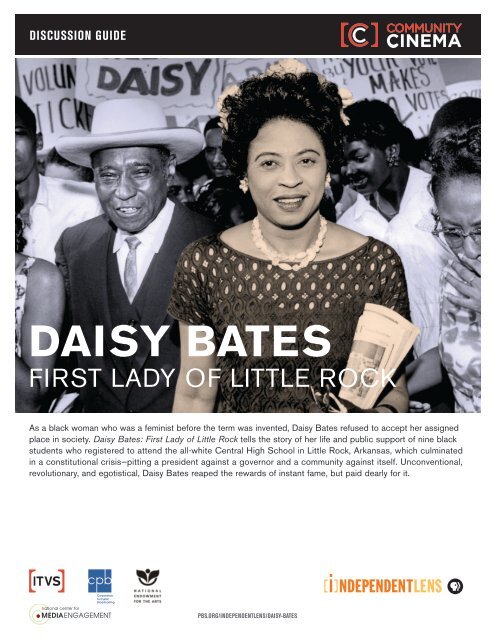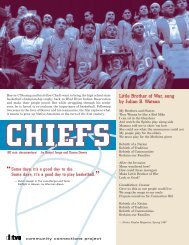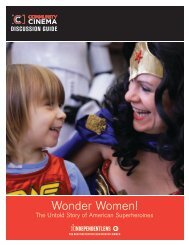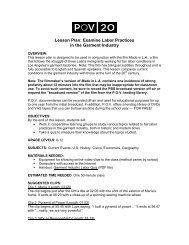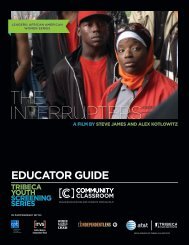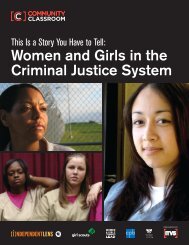Daisy Bates: First Lady of Little Rock - ITVS
Daisy Bates: First Lady of Little Rock - ITVS
Daisy Bates: First Lady of Little Rock - ITVS
You also want an ePaper? Increase the reach of your titles
YUMPU automatically turns print PDFs into web optimized ePapers that Google loves.
DISCUSSION GUIDE<strong>Daisy</strong> <strong>Bates</strong><strong>First</strong> <strong>Lady</strong> <strong>of</strong> <strong>Little</strong> <strong>Rock</strong>As a black woman who was a feminist before the term was invented, <strong>Daisy</strong> <strong>Bates</strong> refused to accept her assignedplace in society. <strong>Daisy</strong> <strong>Bates</strong>: <strong>First</strong> <strong>Lady</strong> <strong>of</strong> <strong>Little</strong> <strong>Rock</strong> tells the story <strong>of</strong> her life and public support <strong>of</strong> nine blackstudents who registered to attend the all-white Central High School in <strong>Little</strong> <strong>Rock</strong>, Arkansas, which culminatedin a constitutional crisis—pitting a president against a governor and a community against itself. Unconventional,revolutionary, and egotistical, <strong>Daisy</strong> <strong>Bates</strong> reaped the rewards <strong>of</strong> instant fame, but paid dearly for it.national center forMEDIA ENGAGEMENTpbs.org/independentlens/daisy-bates
DAISY BATESFrom the Filmmaker:Dear Viewer,Fifteen years ago I stumbled upon the story <strong>of</strong> a woman who had losther parents to violence, but rather than give in to a burning hatredinside <strong>of</strong> her, she became the leader <strong>of</strong> a movement to desegregatethe white schools in Arkansas in 1957. I had studied history all my lifeand considered myself quite knowledgeable, but nowhere in my historybooks did the name <strong>Daisy</strong> <strong>Bates</strong> appear. I felt compelled to findout who this woman was and share her story in the hopes <strong>of</strong> resurrectingher memory in the American consciousness. We filmmakerstend to spend a lot <strong>of</strong> time with our subjects—it’s inevitable that wefall in love with them. In the end, it’s that love that drives us to finishwhat we started, which, like all grand schemes, comes with extremehighs and lows. Today, despite years <strong>of</strong> research, <strong>Daisy</strong> <strong>Bates</strong> stillintrigues me. She was a woman who didn’t fit anyone’s preconceivednotions about women <strong>of</strong> the 1950s. She was beautiful, uneducated,opinionated, and fearless. She smoked and enjoyed her scotch and agood game <strong>of</strong> poker. People who knew <strong>Daisy</strong> <strong>Bates</strong> rarely had mixedfeelings about her—they either loved her or hated her. There are s<strong>of</strong>ew films produced about the women <strong>of</strong> the Civil Rights Movementfrom their point <strong>of</strong> view that my mission from the beginning was tobreak that ceiling.Producing <strong>Daisy</strong> <strong>Bates</strong>: <strong>First</strong> <strong>Lady</strong> <strong>of</strong> <strong>Little</strong> <strong>Rock</strong> taught me as muchabout <strong>Daisy</strong> <strong>Bates</strong> as it did about myself. Looking back, I realize nowthat in committing myself to making this film in 2004, I had done theequivalent <strong>of</strong> jumping <strong>of</strong>f a cliff without a parachute. Once you areover that cliff, there’s no turning back. To complete the film I had tomake sacrifices that impacted my personal and pr<strong>of</strong>essional lives. Iwas forced to become very strategic about how I spent my time andmy finances. The film forced me to let go <strong>of</strong> my initial shyness andbecome much more fearless as I sought out the truth about who<strong>Daisy</strong> <strong>Bates</strong> was. I also learned to be more patient and to acceptrejection without taking it too personally. Throughout the darkestmoments <strong>of</strong> my journey to complete the film I thought <strong>of</strong> <strong>Daisy</strong> <strong>Bates</strong>.I felt she was always with me in spirit—encouraging me, pushingme—and I knew I couldn’t let her down.I hope that when audiences watch the film they will be inspired tobecome leaders in their own communities, educate themselves onwomen from the civil rights movement (<strong>Daisy</strong> <strong>Bates</strong> is only one <strong>of</strong>hundreds <strong>of</strong> unsung heroines from that time period), and use the filmas an inspirational tool to discuss education in American schoolstoday. For young adults, I want the film to be a reminder that whereyour life begins doesn’t have to be where it ends, and I want thosesame teenagers to be inspired by the <strong>Little</strong> <strong>Rock</strong> Nine and their fightto desegregate Central High School so that students today can go toany school they choose to attend.In watching <strong>Daisy</strong> <strong>Bates</strong>: <strong>First</strong> <strong>Lady</strong> <strong>of</strong> <strong>Little</strong> <strong>Rock</strong>, audiences willlearn about a time in history through the eyes <strong>of</strong> a woman whoselife struggles are the stories <strong>of</strong> America at its best and at its worst.Audiences might laugh, they might cry, but they will never be boredas the story <strong>of</strong> <strong>Daisy</strong> <strong>Bates</strong>’s life unfolds before their eyes.Sharon La CruiseSharon La Cruise, Producer/DirectorIndependent Television Service (<strong>ITVS</strong>) email: cinema@itvs.org web: www.communitycinema.orgpage 2
DAISY BATESThe FilmIn the pantheon <strong>of</strong> civil rights leaders, the name <strong>of</strong> <strong>Daisy</strong> <strong>Bates</strong> ishard to find. Yet, this woman was a leader in the civil rights movementand a force behind the 1957 desegregation <strong>of</strong> <strong>Little</strong> <strong>Rock</strong>’sCentral High School. She was a woman <strong>of</strong> courage and convictionwho “knew her place,” which was wherever she wanted to be. Usingarchival footage; still photographs; and interviews with academics,historians, and personal friends, <strong>Daisy</strong> <strong>Bates</strong>: <strong>First</strong> <strong>Lady</strong> <strong>of</strong> <strong>Little</strong><strong>Rock</strong> tells the story <strong>of</strong> this remarkable woman.Growing up in Huttig, Arkansas, in the early decades <strong>of</strong> the 20thcentury, <strong>Daisy</strong> experienced the strict segregation and racism prevalentin the South at the time. At a young age she learned that herbiological mother had been raped and killed by white men and thather father had then abandoned the family. A spirited girl, <strong>Daisy</strong> waseager to leave her small town, and found her ticket out when she metL. C. <strong>Bates</strong>. He was a former reporter turned salesman, 12 years hersenior, wealthy, and fearless. <strong>Daisy</strong> went <strong>of</strong>f with him when she was18, becoming his mistress for the next 10 years.In 1941, the couple moved to <strong>Little</strong> <strong>Rock</strong>, where they purchased theArkansas State Press, the most widely read black newspaper in thestate. The paper provided a voice for the black community, crusadingfor justice and pushing a radical agenda for change. When L. C.taught <strong>Daisy</strong> to use the newspaper as a weapon, she abandoned theparty-girl life she had been living and became a reporter. <strong>Daisy</strong> andL. C. finally married in 1942.At a time when most women—even prominent women—in the civilrights movement were assistants to men, <strong>Daisy</strong> strived to be a leader.In 1948 she attempted to usurp the leadership <strong>of</strong> the NationalAssociation for the Advancement <strong>of</strong> Colored People (NAACP) in<strong>Little</strong> <strong>Rock</strong>, but her actions alienated the organization’s leaders. Fouryears later, however, she ran for president <strong>of</strong> the Arkansas chapter <strong>of</strong>the NAACP and won.After the 1954 Supreme Court decision striking down school segregation,<strong>Daisy</strong> and L. C. began a campaign to persuade blackparents to transfer their children to all-white schools. It took a lawsuitby the NAACP to overcome the recalcitrance <strong>of</strong> the <strong>Little</strong> <strong>Rock</strong>school board, and in September 1957, nine black students—the <strong>Little</strong><strong>Rock</strong> Nine—were chosen to integrate Central High School. As tensionsmounted, Governor Faubus publicly announced that he wasordering the Arkansas National Guard to surround Central High toprevent violence, but those guards were also told to keep all blacksfrom entering the high school. A miscommunication left one student,Elizabeth Eckford, to arrive at the school alone. She was beset by anangry mob <strong>of</strong> white people who heckled and threatened her and followedclose on her heels as she was turned away from the school.The experience created a strain between Elizabeth and <strong>Daisy</strong>, whohad been shepherding the students through the preparation processfor integrating the high school. Strains arose between <strong>Daisy</strong> andothers as well. Some parents <strong>of</strong> the Nine felt left out <strong>of</strong> the process,and many in the black community, fearing for their safety and theirlivelihoods, questioned the tactics <strong>Daisy</strong> and the NAACP were using.White segregationists attacked the <strong>Bates</strong>es’ house, throwing rocksthrough the front window, burning crosses on the lawn and even settingfire to the house itself.Three weeks into the crisis, the black students were finally able toenter Central High School when President Eisenhower sent armytroops to escort them. But even after calm was restored outsidethe school, the Nine experienced daily abuse—verbal and physical—inside the school.The NAACP saw the <strong>Little</strong> <strong>Rock</strong> crisis as a fund-raising opportunityand sent <strong>Daisy</strong> on a speaking tour around the country. This put<strong>Daisy</strong> in the national spotlight as she skillfully used the media to tellthe <strong>Little</strong> <strong>Rock</strong> story. The publicity, however, brought her criticism.Fashionable, glamorous, and outspoken, <strong>Daisy</strong> was accused <strong>of</strong> usingthe events <strong>of</strong> <strong>Little</strong> <strong>Rock</strong> to promote herself.The issue <strong>of</strong> self-promotion arose again in May 1958 when theNAACP awarded the Spingarn Medal, its most prestigious honor, tothe <strong>Little</strong> <strong>Rock</strong> Nine. <strong>Daisy</strong> was not named as a recipient, and shelaunched a campaign to have herself included in the award. Whenseveral <strong>of</strong> the students’ parents threatened to boycott the awardceremony, the NAACP gave in and made <strong>Daisy</strong> one <strong>of</strong> the recipients.The episode left a number <strong>of</strong> people with bitter feelings.In 1959, segregationists made good on a promise to destroy <strong>Daisy</strong><strong>Bates</strong>, targeting the <strong>Bates</strong>es’ newspaper. As advertisers withdrewtheir support, the paper’s revenue declined and the publicationfolded. In an attempt to escape the tensions <strong>of</strong> living in <strong>Little</strong> <strong>Rock</strong>and her troubled marriage, <strong>Daisy</strong> then moved to New York City,where she spent two years writing her autobiography. In 1968,she joined President Lyndon Johnson’s War on Poverty program,which led her to work on economic development in the town <strong>of</strong>Mitchellville, Arkansas, for several years. Toward the end <strong>of</strong> herlife, <strong>Daisy</strong> was in poor health and destitute. When she died, shewas the first female and first African American to lie in state in theArkansas State Capitol.<strong>Daisy</strong> <strong>Bates</strong> has been recognized for her forthright and forcefulefforts to ensure equal educational opportunities for Arkansas’s children.Her leadership in the desegregation <strong>of</strong> Central High Schoollaid the foundation for others in the civil rights movement to take boldaction, and her legacy shows what one heroic and determined individualcan do to change the world.Independent Television Service (<strong>ITVS</strong>) email: cinema@itvs.org web: www.communitycinema.orgpage 3
DAISY BATESSelected individuals featured in<strong>Daisy</strong> <strong>Bates</strong>: <strong>First</strong> <strong>Lady</strong> <strong>of</strong> <strong>Little</strong> <strong>Rock</strong>Pr<strong>of</strong>essor Aldon Morris–Sociologist; author <strong>of</strong> The Origin <strong>of</strong> theCivil Rights MovementPr<strong>of</strong>essor John A. Kirk–Chair <strong>of</strong> the Department <strong>of</strong> History,University <strong>of</strong> Arkansas; author <strong>of</strong> Beyond <strong>Little</strong> <strong>Rock</strong>Elizabeth Jacowey–Historian; author <strong>of</strong> Turn Away Thy SonBeatrice Epps–Childhood friendSybil Hampton-Jordan–FriendBrynda Pappas–FriendLottie Brown Neely–L.C. <strong>Bates</strong>’ cousinDavid Neely–L.C. <strong>Bates</strong>’ cousinMembers <strong>of</strong> <strong>Little</strong> <strong>Rock</strong> Nine:Jefferson ThomasElizabeth EckfordMinnijean Brown-TrickyErnest GreenBACKGROUND INFORMATIONImportant dates in the life <strong>of</strong> <strong>Daisy</strong> <strong>Bates</strong>• November 11, 1914: Born <strong>Daisy</strong> Lee Gatson in Huttig, Arkansas• 1941: Moved to <strong>Little</strong> <strong>Rock</strong> with L. C. <strong>Bates</strong>, where they took overthe weekly newspaper, the Arkansas State Press• March 4, 1942: Married L. C. <strong>Bates</strong>• 1952: Elected president <strong>of</strong> the Arkansas Conference <strong>of</strong> Branches<strong>of</strong> the NAACP• 1957–1958: Led the struggle to desegregate Central High School• 1959: The <strong>Bates</strong>es closed the Arkansas State Press due to segregationists’boycott <strong>of</strong> advertisers and campaign <strong>of</strong> intimidation• 1960: Moved to New York to write her memoir, The Long Shadow<strong>of</strong> <strong>Little</strong> <strong>Rock</strong>• August 28, 1963: One <strong>of</strong> only three women to speak at theLincoln Memorial at the March on Washington• 1968–1974: Moved to the all-black town <strong>of</strong> Mitchellville, Arkansas,to work with President Johnson's federal antipoverty program• 1984: Revived the Arkansas State Press, selling it in 1987• November 4, 1999: Died <strong>of</strong> a heart attack in <strong>Little</strong> <strong>Rock</strong>, ArkansasCivil rights and the NAACPThe struggle for civil rights for blacks has occurred throughout U.S.history, encompassing every aspect <strong>of</strong> America’s economic, social,cultural, and political lives. It’s a familiar story, beginning with thepolitical strife surrounding the abolition <strong>of</strong> slavery, followed by decades<strong>of</strong> Jim Crow laws, when blacks were no longer in bondage but hadseverely limited opportunities. Whites' feelings <strong>of</strong> enmity and hostilitytoward blacks <strong>of</strong>ten resulted in lynchings and race riots. One suchriot, in Springfield, Illinois, in 1908, led to the formation <strong>of</strong> the NationalAssociation for the Advancement <strong>of</strong> Colored People—the NAACP.Founded on February 12, 1909, by a multiracial, multireligiousgroup <strong>of</strong> men and women, the stated goal <strong>of</strong> the NAACP was “tosecure for all people the rights guaranteed in the 13th, 14th, and15th Amendments to the United States Constitution, which promisedan end to slavery, the equal protection <strong>of</strong> the law, and universaladult male suffrage, respectively.” The NAACP's highest honor, theSpingarn Medal, named for J. E. Spingarn, one <strong>of</strong> the organization’searly leaders, is awarded annually to an African American man orwoman for outstanding achievement.Since its inception, the NAACP has taken leading roles in publiccampaigns and lawsuits aimed at ending racial discrimination in theU.S.—in the movie industry (the 1915 protest against D. W. Griffith’sracially inflammatory Birth <strong>of</strong> a Nation); in the military (through lobbyingpressure and White House meetings with Presidents Rooseveltand Truman); in the election process (pressing for voting rights andvoter registration from 1915 through the 1960s); and in housing andthe economy (ongoing efforts to end discriminatory laws in housingand predatory lending practices).One <strong>of</strong> the NAACP’s biggest victories was the landmark 1954 SupremeCourt decision that struck down school segregation, and it provided<strong>Daisy</strong> <strong>Bates</strong> with the cause that brought her to national attention.Ending School SegregationAttempts to end segregation in public schools began long before theevents in <strong>Little</strong> <strong>Rock</strong> in 1957, and even before the Supreme Courtdecision in Brown v. Board <strong>of</strong> Education <strong>of</strong> Topeka in 1954. Asmuch as a century earlier, courts began hearing cases brought byblack parents who charged the schools with providing their childreninferior educational opportunities because <strong>of</strong> discriminatory treatmentbased on their race. Some <strong>of</strong> these cases, including a series<strong>of</strong> Kansas cases between 1881 and 1949, revolved around narrowissues such as student safety or teacher qualifications, and somecases dealt only with matters pertaining to higher education. While anumber <strong>of</strong> the cases were decided in the plaintiffs’ favor, those decisionsapplied only to the issues at hand and did not affect schoolsegregation in general. The fact remained that in 17 states and theDistrict <strong>of</strong> Columbia, segregation in schools as well as in other publicfacilities was the law.Class ActionProgress toward school desegregation picked up steam when fivecases—all brought by the NAACP’s Legal Action Fund—came beforethe Supreme Court in 1952. The cases—from Delaware; Kansas;Washington, D.C.; South Carolina; and Virginia—had been unsuccessfulin the lower courts. The facts <strong>of</strong> each case were different, butthe central issue in each was the constitutionality <strong>of</strong> state-sponsoredsegregation in public schools. The Supreme Court chose to consolidatethe cases under the name <strong>of</strong> the Kansas case, Brown v. Board<strong>of</strong> Education <strong>of</strong> Topeka. Because the Court did not reach a decisionby the end <strong>of</strong> its term, it reheard the case in 1953. After muchdebate and discussion among the deeply divided justices, the Courthanded down a unanimous decision on May 17, 1954, striking downIndependent Television Service (<strong>ITVS</strong>) email: cinema@itvs.org web: www.communitycinema.org page 4
DAISY BATESschool segregation, saying that separate schools for white and blackchildren violated the equal protection clause <strong>of</strong> the 14th Amendment.Sources: brownvboard.org/content/court-cases-preludebrown-1849-1949;www.uscourts.gov/EducationalResources/ConstitutionResources/LegalLandmarks/HistoryOfBrownVBoardOfEducation.aspxMassive ResistanceAfter the Brown decision, the reaction throughout the South was anythingbut compliant. The congressional delegations <strong>of</strong> most Southernstates signed on to the Southern Manifesto, a document declaringopposition to desegregation and promising to use all lawful means toreverse the Court’s decision. Virginia established a policy <strong>of</strong> massiveresistance, and schools were closed in order to avoid integrating.Massive resistance also took hold in Alabama and Arkansas.In 1955, in a case known as Brown II, the Supreme Court askeddistrict courts to take over the task <strong>of</strong> carrying out school desegregation,with orders that the process occur "with all deliberate speed.”Supporters <strong>of</strong> the original Brown decision deemed the Court’s languagetoo ambiguous and many Southern states used this ambiguity as justificationfor resisting, delaying, and avoiding significant integration for years.The <strong>Little</strong> <strong>Rock</strong> ExperienceShortly after the Brown decision, Arkansas announced that it wouldbegin taking steps to comply with the Supreme Court’s ruling,pending guidelines from the Court regarding the method and timeframe for implementation. In <strong>Little</strong> <strong>Rock</strong>, where desegregation hadalready taken place in many public facilities such as libraries, parks,and public buses, school leaders developed a graduated plan thatwould desegregate Central High School in 1957, junior high schoolsby 1960, and elementary schools by 1963. In the intervening yearsbetween the Court’s decision and its planned implementation, oppositionto desegregation grew. White citizens’ councils emerged inArkansas and other Southern states to promote public resistanceto desegregation. Newspaper ads and rallies, along with threats<strong>of</strong> violence, fed the resistance fervor. Citizens’ groups petitionedGovernor Orval Faubus to prevent desegregation at Central HighSchool, and an injunction was granted in order to avert the expectedviolence. The district court, however, nullified the injunction and orderedthe <strong>Little</strong> <strong>Rock</strong> School Board to proceed with its desegregation plan.To deal with the ensuing chaos and near-riot conditions, PresidentEisenhower sent in federal troops to protect the nine black studentswho began attending Central High School in September 1957. Evenafter calm was restored outside <strong>of</strong> the school, however, the <strong>Little</strong><strong>Rock</strong> Nine endured constant physical and verbal abuse from theother students for the remainder <strong>of</strong> the year. For their abusive behavior,more than one hundred white students were suspended and fourwere expelled. During that year, one <strong>of</strong> the Nine, Minnijean Brown,was also expelled for retaliating against the abuse.Civil Rights Challenges TodayIn the nearly 60 years since the Supreme Court struck down school segregation,Congress and the courts have issued rulings and laws, such asthe Voting Rights Act <strong>of</strong> 1965 and the Equal Employment OpportunityAct <strong>of</strong> 1972, aimed at removing some <strong>of</strong> the last vestiges <strong>of</strong> discriminationin the U.S. But challenges remain. In many communities, schoolshave become resegregated, based on residence patterns and the desire<strong>of</strong> parents to send their children to a neighborhood school. In these places,school <strong>of</strong>ficials struggle with achieving and maintaining district-wideequality among schools.According to Education Week magazine, every school day, more thanseventy-two hundred students fall through the cracks <strong>of</strong> America's publichigh schools. Thirty percent <strong>of</strong> this year's graduating class, 1.3 millionstudents in all, will fail to graduate with a diploma. President Obamacalled this reality a “crisis” that the nation cannot afford to accept orignore. Graduating from high school, he said, is an “economic imperative.”According to the National Center for Education Statistics, themedian income for high school dropouts aged 18 to 67 years old wasroughly $23,000 in 2008. By comparison, the median income <strong>of</strong> persons<strong>of</strong> the same age range who earned their high school credentials is$42,000. Over a person’s lifetime, this translates into a loss <strong>of</strong> approximately$630,000 in income. Further, dropouts age 25 and older reportedbeing in worse health than adults who are not dropouts, regardless <strong>of</strong>income. Dropouts also make up disproportionately high percentages<strong>of</strong> the nation’s prison and death row inmates, have a higher reliance onMedicaid and Medicare, have higher rates <strong>of</strong> criminal activities, and havea higher rate <strong>of</strong> reliance on welfare.In housing, predatory lending has left many <strong>of</strong> the most vulnerable members<strong>of</strong> society foreclosed from their homes and from the AmericanDream. The criminal justice system <strong>of</strong>ten deals out harsher penalties topoor blacks and other minorities, particularly in the area <strong>of</strong> drug enforcement.And as the 2012 election approaches, there is discussion <strong>of</strong> tacticsdesigned to limit the ability <strong>of</strong> certain groups to vote.A USA Today poll* taken on the eve <strong>of</strong> the dedication <strong>of</strong> the MartinLuther King Jr. Memorial shows that a significant gulf persists betweenthe views <strong>of</strong> blacks and whites regarding what the civil rights movementhas achieved and how much remains to be done. Meanwhile, efforts toachieve equal rights for other groups, such as gays, immigrants, and thedisabled are a reminder that similar issues affect all minorities. Sadly,the occasional hate crime committed against a member <strong>of</strong> one <strong>of</strong> theseminorities underscores the need for continued vigilance and attention tothe enforcement <strong>of</strong> existing civil rights laws.*www.usatoday.com/news/nation/2011-08-17-race-equality-pollmlk_n.htmSources: encyclopedia<strong>of</strong>arkansas.net/encyclopedia/entry-detail.aspx?entryID=718; www.ourdocuments.gov/doc.php?doc=89Independent Television Service (<strong>ITVS</strong>) email: cinema@itvs.org web: www.communitycinema.org page 5
DAISY BATESTOPICS AND ISSUES RELEVANTTO <strong>Daisy</strong> <strong>Bates</strong>: <strong>First</strong> <strong>Lady</strong> <strong>of</strong><strong>Little</strong> <strong>Rock</strong>A screening <strong>of</strong> <strong>Daisy</strong> <strong>Bates</strong>: <strong>First</strong> <strong>Lady</strong> <strong>of</strong> <strong>Little</strong> <strong>Rock</strong> can be used tospark interest in any <strong>of</strong> the following topics and inspire both individualand community action. In planning a screening, consider finding speakers,panelists, or discussion leaders who have expertise in one or more<strong>of</strong> the following areas:• The civil rights movement• School desegregation• Equal opportunity in education• Leadership skills and the importance <strong>of</strong> community activism• Social and political activism• Feminism• Gender roles• Race relations todayTHINKING MORE DEEPLY1. What is your assessment <strong>of</strong> <strong>Daisy</strong> <strong>Bates</strong> as a person? Do youfeel she was a self-promoter? What words would you use todescribe her?2. Had you ever heard <strong>of</strong> <strong>Daisy</strong> <strong>Bates</strong> before seeing this film? Whyis she not more widely known as a prominent figure in the history<strong>of</strong> the civil rights movement?3. How many women can you name from the civil rights movement?4. If a man had been in <strong>Daisy</strong> <strong>Bates</strong>’s position, would he have doneanything differently with regard to the implementation <strong>of</strong> theSupreme Court decision on school desegregation? How mightevents have unfolded differently?5. Do you think <strong>Daisy</strong>’s being female was a help or a hindrance inher fight to achieve civil rights for blacks? Explain your answer.6. Why did some leaders <strong>of</strong> the black community in <strong>Little</strong> <strong>Rock</strong> feelthat change should be more gradual? Would desegregation havebeen less confrontational if it had taken place more slowly or ata later date? Would it have been more beneficial for race relations?Why or why not?7. Why did the <strong>Little</strong> <strong>Rock</strong> Nine not strike back when they wereabused by the white students at Central High School? What doyou think would have happened if they had hit back or lashed out?8. Are you surprised that the black community was divided in itsattitude toward the integration <strong>of</strong> <strong>Little</strong> <strong>Rock</strong>’s schools? Whatdid one person in the community mean when he said, “Why areyou messing it up for the rest <strong>of</strong> us?”9. Do you think <strong>Daisy</strong> <strong>Bates</strong> deserved to receive the NAACP’sSpingarn Medal? Why wasn’t she included as a recipient alongwith the <strong>Little</strong> <strong>Rock</strong> students?10. Was <strong>Daisy</strong> <strong>Bates</strong> like other civil rights leaders you are familiarwith? If so, in what ways? How was she different?11. How would you characterize the state <strong>of</strong> race relations in theU.S. today? What effect, if any, has the election <strong>of</strong> a blackpresident had on relations between blacks and whites?12. If given the chance, would you do what <strong>Daisy</strong> <strong>Bates</strong> did? Wouldyou risk your marriage, livelihood, and standing in your community?13. Is there a public issue today that could benefit from someonelike <strong>Daisy</strong> <strong>Bates</strong> taking it on? Explain.Independent Television Service (<strong>ITVS</strong>) email: cinema@itvs.org web: www.communitycinema.orgpage 6
DAISY BATESSUGGESTIONS FOR ACTIONTogether with other audience members, brainstorm actions that youmight take as an individual and that people might do as a group.Here are some ideas to get you started:1. Check out NAACP’s Action Alerts and find out how you can getinvolved. As a member, you can also choose to work on one <strong>of</strong>the NAACP’s many advocacy issues. More information is availableat www.naacp.org/pages/take-action.2. Women and Girls Lead is an initiative <strong>of</strong> the IndependentTelevision Service (<strong>ITVS</strong>). Visit their webpage (www.itvs.org/women-and-girls-lead/get-involved) to learn how you can helpgirls in your community develop leadership skills by participatingin service activities.3. Learn about the civil rights leaders in your community—thosewho were active in the 1950s and 1960s as well as those whoare active today. Find out what civil rights issues are currentlyoccupying their attention and how you can get involved.4. Education–<strong>Daisy</strong> <strong>Bates</strong> had no children yet she decided to takean active role in the education <strong>of</strong> children in her community; untilher death she was known to visit the schools in <strong>Little</strong> <strong>Rock</strong> andread to the young students. Would you consider joining yourlocal Parent Teacher Association (PTA) and also taking an activerole in the schools in your community?5. The American Civil Liberties Union (ACLU) works on numerouscivil liberties issues including racial justice. Contribute to theACLU’s efforts by taking action on one <strong>of</strong> the issues you feelstrongly about. Visit www.aclu.org for more information.6. Organize a discussion about the state <strong>of</strong> race relations in yourcommunity. Invite a mixed (racially and generationally) panel <strong>of</strong>experts to spearhead the discussion. Encourage the participation<strong>of</strong> as diverse an audience as possible.7. Is there a social, political, environmental, or other condition youwould like to see changed? Make your voice heard on the issueby writing to your elected representatives and to local newspapersand other media. Learn how to organize your communityto mount a larger effort to work for change. Two resources thatcan help are “Bottoms Up: A Guide to Grassroots Organizing”(www.november.org/BottomsUp/index.html) and CommonDreams (www.commondreams.org).For additional outreach ideas, visit www.itvs.org, the website <strong>of</strong> theIndependent Television Service. For local information, check the website<strong>of</strong> your PBS station.Independent Television Service (<strong>ITVS</strong>) email: cinema@itvs.org web: www.communitycinema.orgpage 7
DAISY BATESRESOURCESwww.itvs.org/films/daisy-bates—This is the <strong>ITVS</strong> website devoted tothe film <strong>Daisy</strong> <strong>Bates</strong>: <strong>First</strong> <strong>Lady</strong> <strong>of</strong> <strong>Little</strong> <strong>Rock</strong>.www.itvs.org/women-and-girls-lead—Women and Girls Lead is amultiyear public media initiative to support and empower girls as theystep into leadership roles; work to improve their communities; andcreate innovations in science, the arts, business, and governance.<strong>Daisy</strong> <strong>Bates</strong> Biographical Informationlibinfo.uark.edu/SpecialCollections/findingaids/batesaid/batesaid.html—The <strong>Daisy</strong> <strong>Bates</strong> Papers at the University <strong>of</strong> Arkansas cataloguescorrespondence, photographs, newspaper clippings, and other memorabilia.The website includes a brief biography <strong>of</strong> <strong>Daisy</strong> <strong>Bates</strong>.encyclopedia<strong>of</strong>arkansas.net/encyclopedia/entry-detail.aspx?entryID=591—The Encyclopedia <strong>of</strong> Arkansas History & Culturecontains a biography <strong>of</strong> <strong>Daisy</strong> <strong>Bates</strong>, including her involvement inschool desegregation in <strong>Little</strong> <strong>Rock</strong>.Civil Rights Historywww.infoplease.com/spot/civilrightstimeline1.html—This webpagecontains a time line <strong>of</strong> milestones in the civil rights movement, from1948 through 2009.www.loc.gov/exhibits/brown/brown-aftermath.html—This Library <strong>of</strong>Congress webpage provides photos and brief descriptions <strong>of</strong> themajor events from the civil rights movement.en.wikipedia.org/wiki/Brown_v._Board_<strong>of</strong>_Education—The map onthis website shows the 17 states where segregation in schools andpublic facilities was legal prior to the Brown decision.brownvboard.org—The Brown Foundation for Educational Equity,Excellence and Research serves as a living tribute to the attorneys,community organizers, and plaintiffs in the landmark U.S. SupremeCourt decision <strong>of</strong> May 17, 1954: Brown v. Board <strong>of</strong> Education <strong>of</strong>Topeka. Its mission is to keep the tenets and ideals <strong>of</strong> Brown relevantfor future generations through programs, preservation, advocacy, andcivic engagement. The website contains historical information on thelegal cases, decisions, and events surrounding Brown as well as earliercases pertaining to school desegregation.clinton2.nara.gov/Initiatives/OneAmerica/PIR_summary.pdf—This isthe executive summary <strong>of</strong> “One America in the 21st Century: Forginga New Future,” a report <strong>of</strong> President Clinton’s 1997 Initiative on Race.Civil Rights Organizationswww.naacp.org/content/main—The National Association for theAdvancement <strong>of</strong> Colored People works to ensure the political,educational, social, and economic equality <strong>of</strong> rights <strong>of</strong> all personsand to eliminate race-based discrimination.hwww.civilrights.org—The Leadership Conference on Civil andHuman Rights is a coalition <strong>of</strong> more than two hundred nationalorganizations that promotes and protects the civil and human rights<strong>of</strong> all persons in the United States through legislative advocacy andoutreach to targeted constituencies.www.aclu.org—The ACLU works in courts, legislatures, and communitiesto defend and preserve the individual rights and libertiesguaranteed by the Constitution and laws <strong>of</strong> the United States. TheACLU also works to extend rights to segments <strong>of</strong> our population thathave traditionally been denied their rights, including people <strong>of</strong> colorand women.Female Leaderswww.msnbc.msn.com/id/9862643/ns/us_news-life/t/women-hadkey-roles-civil-rights-movement—Thisarticle about women in the civilrights movement describes their contribution and explains why theyremained largely unknown to the public. (Note: The article does notmention <strong>Daisy</strong> <strong>Bates</strong>.)www.infoplease.com/spot/whmbios3.html—This website contains acomprehensive list <strong>of</strong> female reformers and activists, including bothhistorical and contemporary figures.www.historyswomen.com/socialreformers.html—History’s Womenlists a variety <strong>of</strong> “unsung heroines” who were leaders, activists, crusaders,and reformers.Female Leaderswww.msnbc.msn.com/id/9862643/ns/us_news-life/t/women-hadkey-roles-civil-rights-movement—Thisarticle about Women in the civilrights movement describes their contribution and explains why theyremained largely unknown to the public. (Note: The article does notmention <strong>Daisy</strong> <strong>Bates</strong>.)Independent Television Service (<strong>ITVS</strong>) email: cinema@itvs.org web: www.communitycinema.orgpage 8


